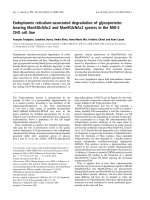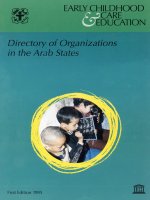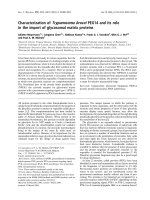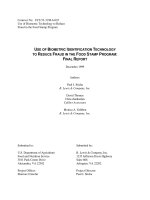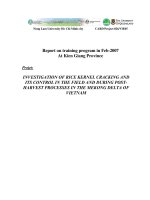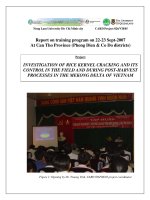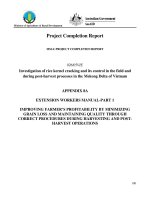OCEANOGRAPHIC PROCESSES OF CORAL REEFS: Physical and Biological Links in the Great Barrier Reef - Chapter 1 docx
Bạn đang xem bản rút gọn của tài liệu. Xem và tải ngay bản đầy đủ của tài liệu tại đây (199.41 KB, 19 trang )
OCEANOGRAPHIC PROCESSES
OF CORAL REEFS
Physical and Biological Links
in the
Great Barrier Reef
© 2001 by CRC Press LLC
OCEANOGRAPHIC PROCESSES
OF CORAL REEFS
Physical and Biological Links
in the
Great Barrier Reef
Edited by
Eric Wolanski, Ph.D., FTSE
Australian Institute of Marine Science
Townsville, Queensland, Australia
Boca Raton London New York Washington, D.C.
CRC Press
© 2001 by CRC Press LLC
Library of Congress Cataloging-in-Publication Data
Oceanographic processes of coral reefs : physical and biological links in the Great
Barrier Reef / edited by Eric Wolanski.
p. cm.
Includes bibliographical references (p. ).
ISBN 0-8493-0833-X (alk. paper)
1. Coral reef ecology Australia Great Barrier Reef (Qld.) 2. Coral reef
biology Australia Great Barrier Reef (Qld.) 3. Oceanography Australia Great Barrier
Reef (Qld.) 4. Great Barrier Reef (Qld.) I. Wolanski, Eric.
QH197 .034 2000
577.7′89476 dc21 00-048569
CIP
This book contains information obtained from authentic and highly regarded sources. Reprinted material
is quoted with permission, and sources are indicated. A wide variety of references are listed. Reasonable
efforts have been made to publish reliable data and information, but the author and the publisher cannot
assume responsibility for the validity of all materials or for the consequences of their use.
The opinions expressed in this book are not necessarily those of the authors’ institutions, the editor, or the
publisher. Accuracy in calculations, figures, tables, names, quotations, references, etc. is the complete
responsibility of the author(s) of individual invited papers. All papers were peer reviewed.
Neither this book nor any part may be reproduced or transmitted in any form or by any means, electronic
or mechanical, including photocopying, microfilming, and recording, or by any information storage or
retrieval system, without prior permission in writing from the publisher.
All rights reserved. Authorization to photocopy items for internal or personal use, or the personal or inter-
nal use of specific clients, may be granted by CRC Press LLC, provided that $.50 per page photocopied is
paid directly to Copyright Clearance Center, 222 Rosewood Drive, Danvers, MA 01923 USA. The fee code
for users of the Transactional Reporting Service is ISBN 0-8493-0833-X-0/01/$0.00+$.50. The fee is sub-
ject to change without notice. For organizations that have been granted a photocopy license by the CCC, a
separate system of payment has been arranged.
The consent of CRC Press LLC does not extend to copying for general distribution, for promotion, for cre-
ating new works, or for resale. Specific permission must be obtained in writing from CRC Press LLC for
such copying.
Direct all inquiries to CRC Press LLC, 2000 N.W. Corporate Blvd., Boca Raton, Florida 33431.
Trademark Notice: Product or corporate names may be trademarks or registered trademarks, and are used
only for identification and explanation, without intent to infringe.
© 2001 by CRC Press LLC
No claim to original U.S. Government works
International Standard Book Number 0-8493-0833-X
Library of Congress Card Number 00-048569
Printed in the United States of America 1 2 3 4 5 6 7 8 9 0
Printed on acid-free paper
© 2001 by CRC Press LLC
Foreword
I have maintained an on-going and deep interest in the Great Barrier Reef ever since
I was involved in the establishment of the Australian Institute of Marine Science more
than 25 years ago. This book contains important chapters dealing with different
aspects of the functioning of the ecosystem in relation to the Great Barrier Reef and
demonstrates the impact of human activities on the Great Barrier Reef.
While progress is continually being made scientifically with our knowledge of
the ecosystem, we should constantly have in mind how important it is to preserve and
protect the Great Barrier Reef for future generations. There is a delicate balance, and
the impact of variations in climate and pollution from such things as mud, fishing,
runoff from clearing catchments, mining, etc. all need to be closely monitored.
The current generation should not take unnecessary risks to satisfy economic
imperatives if there is even the smallest chance of spoiling any part of this unique
heritage.
I commend this book for its comprehensive coverage of the links between phys-
ical and biological processes in the Great Barrier Reef. I hope it will create construc-
tive discussion and awareness of the potential pitfalls and possibilities for the region.
The Right Honourable Malcolm Fraser, A.C., C.H.
© 2001 by CRC Press LLC
Dedication
I dedicate this book to my sons, Philippe and Timothy,
born and brought up on the shores of the Great Barrier
Reef; I hope that something will remain for them to
entrust to their children.
Eric Wolanski
© 2001 by CRC Press LLC
About the Editor
Dr. Eric Wolanski received his B.Sc. in civil engineering in 1969 from the Catholic
University of Louvain, his M.Sc. in civil and geological engineering in 1970 from
Princeton University, and his Ph.D. in environmental engineering in 1972 from The
Johns Hopkins University. He is a Fellow of the Australian Academy of
Technological Sciences and Engineering and a Corresponding Member of the
Académie Royale Belge des Sciences d’Outre-Mer. He is a member of the Sigma Xi
Research Society of North America and the Australian Institution of Engineers. He is
an editor of the scientific journal Estuarine, Coastal and Shelf Science; a member of
the editorial advisory board of the scientific journals Continental Shelf Research,
Journal of Coastal Research, Wetlands Ecology and Management, Journal of Marine
Systems, and Oceanographic Literature Review; and a Theme Editor of UNESCO’s
Encyclopedia of Life Supporting Systems. He has published more than 200 research
papers. For the last 22 years at the Australian Institute of Marine Science, where he
is a Senior Principal Research Scientist, he has been studying tropical coastal
oceanography and its biological implications for mangroves and coral reefs.
© 2001 by CRC Press LLC
Contributors
Joe Baker, Ph.D., OBE, FTSE,
FRACI
Commissioner for the Environment,
A.C.T.
P.O. Box 356
Dickson 2602, Australia
and
Chief Scientist, D.P.I.
GPO Box 46
Brisbane, Queensland 4001, Australia
E-mail:
Dietrich G. Bengen
Center for Coastal and Marine
Resources Studies
Gedung Marine Centre Lantai 4
Fakultas Perikanan dan Ilmu
Kelautan—IPB, Kampus IPB
Darmaga, Bagor, Indonesia 16680
E-mail:
Robert G.V. Bramley
CSIRO Land and Water
PMB 2
Glen Osmond, South Australia 5064
Australia
and
Cooperative Research Centre for
Sustainable Sugar Production
James Cook University
of North Queensland
Douglas, Queensland 4811, Australia
E-mail:
Richard Brinkman
Australian Institute of Marine Science
PMB 3
Townsville MC, Queensland 4810,
Australia
E-mail:
Mike Cappo
Australian Institute of Marine Science
PMB 3
Townsville MC, Queensland 4810,
Australia
E-mail:
John H. Carleton
Australian Institute of Marine Science
PMB 3
Townsville MC, Queensland 4810,
Australia
E-mail:
Glenn De’ath
Cooperative Research Centre for the
Great Barrier Reef World Heritage Area
James Cook University
Townsville, Queensland 4811, Australia
and
Tropical Environment Studies and
Geography
James Cook University
Townsville, Queensland 4811, Australia
E-mail:
Eric Deleersnjider
Institut d’Astronomie
et de Géophysique G. Lemaître
Université Catholique de Louvain
2 Chemin du Cyclotron
B1348 Louvain-la-Neuve, Belgium
E-mail:
Peter J. Doherty
Australian Institute of Marine Science
PMB 3
Townsville MC, Queensland 4810,
Australia
E-mail:
© 2001 by CRC Press LLC
Terry Done
Australian Institute of Marine Science
PMB 3
Townsville MC, Queensland 4810,
Australia
E-mail:
Edward A. Drew
P.O. Box 361
Castletown, Townsville, Queensland
4810, Australia
E-mail:
Norman C. Duke
Botany Department
University of Queensland
St. Lucia, Queensland 4072, Australia
Ian M. Dutton
Proyek Pesisir
Ratu Plaza Building 18th Floor
Jl. Jend. Sudirman 9,
Jakarta, Indonesia 10270
E-mail:
Katharina Fabricius
Australian Institute of Marine Science
PMB 3
Townsville MC, Queensland 4810,
Australia
and
Cooperative Research Centre
for the Great Barrier Reef World
Heritage Area
James Cook University
Townsville, Queensland 4811,
Australia
E-mail:
Miguel Fortes
SEALAB-Marine Science Institute
University of the Philippines
Diliman, Quezon City, Philippines 1101
E-mail:
The Right Honourable
Malcolm Fraser, AC, CH
44th Floor, ANZ Tower
55 Collins Street
Melbourne, Victoria 3000, Australia
Fax: 61-3-96541301
Miles Furnas
Australian Institute of Marine Science
PMB 3
Townsville MC, Queensland 4810,
Australia
and
Cooperative Research Centre
for the Great Barrier Reef World
Heritage Area
James Cook University
Townsville, Queensland 4811, Australia
E-mail:
Keita Furukawa
Port and Harbour Research Institute
1-1, 3 Chome
Nagase, Yokosuka 239-0826, Japan
E-mail:
Neil A. Gribble
Queensland Department of Primary
Industry
Northern Fisheries Centre
P.O. Box 5396
Cairns, Queensland 4870, Australia
and
Collaborative Research Centre
for the Great Barrier Reef World
Heritage Area
James Cook University
Townsville, Queensland 4811, Australia
E-mail:
John Guinotte
Australian Institute of Marine Science
PMB 3
Townsville MC, Queensland 4810,
Australia
E-mail:
© 2001 by CRC Press LLC
E-mail:
Andrew K.L. Johnson
CSIRO Tropical Agriculture
120 Meiers Road
Indooropilly, Queensland 4068,
Australia
and
Cooperative Research Centre
for Sustainable Sugar Production
James Cook University
of North Queensland
Townsville, Queensland 4811, Australia
E-mail:
Russell Kelley
Watermark Films
P.O. Box 1859
Townsville, Queensland 4810, Australia
E-mail:
Brian King
Asia–Pacific Applied Science
Associates
P.O. Box 1679
Surfers Paradise, Queensland 4217,
Australia
E-mail:
Johnson Kitheka
Kenya Marine Fisheries Research
Institute
P.O. Box 81651
Mombasa, Kenya
E-mail:
Janice M. Lough
Australian Institute of Marine Science
PMB 3
Townsville MC, Queensland 4810,
Australia
E-mail:
Yoshihiro Mazda
Department of Marine Science
Tokai University
3-20-1 Orido
Shimizu City, Shizuoka Pref. 424, Japan
E-mail:
Felicity McAllister
Australian Institute of Marine Science
PMB 3
Townsville MC, Queensland 4810,
Australia
E-mail:
Laurence J. McCook
Australian Institute of Marine Science
PMB 3
Townsville MC, Queensland 4810,
Australia
and
Collaborative Research Centre for the
Great Barrier Reef World Heritage
Area
James Cook University
Townsville, Queensland 4811, Australia
E-mail:
Alan Mitchell
Australian Institute of Marine Science
PMB 3
Townsville MC, Queensland 4810,
Australia
E-mail:
Peter Ridd
School of Mathematical and Physical
Sciences
James Cook University
Townsville, Queensland 4811, Australia
E-mail:
Christian H. Roth
CSIRO Land and Water
PMB PO
Aitkenvale, Queensland 4814, Australia
E-mail:
William Skirving
Australian Institute of Marine Science
PMB 3
Townsville MC, Queensland 4810,
Australia
E-mail:
© 2001 by CRC Press LLC
Simon Spagnol
Australian Institute of Marine Science
PMB 3
Townsville MC, Queensland 4810,
Australia
E-mail:
Peter Speare
Australian Institute of Marine Science
PMB 3
Townsville MC, Queensland 4810,
Australia
E-mail:
Craig R. Steinberg
Australian Institute of Marine Science
PMB 3
Townsville MC, Queensland 4810,
Australia
E-mail:
Thomas Stieglitz
School of Mathematical and Physical
Sciences
James Cook University
Townsville, Queensland 4811, Australia
E-mail:
David Suzuki
David Suzuki Foundation
219-2211 West Fourth Avenue
Vancouver, B.C. V6K 4S2, Canada
Fax: 1-604-730-9672
Frank H. Talbot
Graduate School of the Environment
Division of Environmental and Life
Sciences
College of Science and Technology
Macquarie University
New South Wales 2109, Australia
E-mail:
J. Johnnes Tulungen
Proyek Pesisir Manado, Jl. Wolter
Mongisi No. 5, Kleak Lingkungan I
Manado, North Sulawesi, Indonesia
95115
E-mail:
Eric Wolanski, FTSE
Australian Institute of Marine Science
PMB 3
Townsville MC, Queensland 4810,
Australia
E-mail:
© 2001 by CRC Press LLC
Contents
Note: A CD-ROM containing figures and animations accompanies this book.
Readers can access the contents on this CD-ROM by opening the file default.htm. If
any problem occurs, instructions on accessing this CD-ROM can be found in the file
help.htm.
Foreword
The Right Honourable Malcolm Fraser, A.C., C.H.
Introduction
Oceanographic Processes of Coral Reefs
David Suzuki
Chapter 1
The Place of Science and Technology in the Wise Management
of the Great Barrier Reef. . . . . . . . . . . . . . . . . . . . . . . . . . . . . . . . . . . . . . . . . . . . . . 1
Joe Baker
Chapter 2
Physics–Biology Links in the Great Barrier Reef. . . . . . . . . . . . . . . . . . . . . . . . . . . 7
Eric Wolanski
Chapter 3
Landcover and Water Quality in River Catchments of the Great
Barrier Reef Marine Park . . . . . . . . . . . . . . . . . . . . . . . . . . . . . . . . . . . . . . . . . . . . 19
Andrew K.L. Johnson, Robert G.V. Bramley, and Christian H. Roth
Chapter 4
Runoff of Terrestrial Sediment and Nutrients into the Great Barrier
Reef World Heritage Area . . . . . . . . . . . . . . . . . . . . . . . . . . . . . . . . . . . . . . . . . . . . 37
Miles Furnas and Alan Mitchell
Chapter 5
Water Circulation in Mangroves, and Its Implications for Biodiversity . . . . . . . . . 53
Eric Wolanski, Yoshihiro Mazda, Keita Furukawa, Peter Ridd,
Johnson Kitheka, Simon Spagnol, and Thomas Stieglitz
Chapter 6
Muddy Coastal Waters and Depleted Mangrove Coastlines—
Depleted Seagrass and Coral Reefs. . . . . . . . . . . . . . . . . . . . . . . . . . . . . . . . . . . . . 77
Norman C. Duke and Eric Wolanski
© 2001 by CRC Press LLC
Chapter 7
The Effects of Siltation on Tropical Coastal Ecosystems . . . . . . . . . . . . . . . . . . . . 93
Miguel Fortes
Chapter 8
Modelling and Visualising Interactions between Natural Disturbances and
Eutrophication as Causes of Coral Reef Degradation. . . . . . . . . . . . . . . . . . . . . . 113
Laurence J. McCook, Eric Wolanski, and Simon Spagnol
Chapter 9
Biodiversity on the Great Barrier Reef: Large-Scale Patterns
and Turbidity-Related Local Loss of Soft Coral Taxa. . . . . . . . . . . . . . . . . . . . . . 127
Katharina Fabricius and Glenn De’ath
Chapter 10
River Plume Dynamics in the Central Great Barrier Reef . . . . . . . . . . . . . . . . . . 145
Brian King, Felicity McAllister, Eric Wolanski, Terry Done,
and Simon Spagnol
Chapter 11
Connectivity in the Great Barrier Reef World Heritage Area—
An Overview of Pathways and Processes . . . . . . . . . . . . . . . . . . . . . . . . . . . . . . . 161
Mike Cappo and Russell Kelley
Chapter 12
A Model of the Ecosystem, and Associated Penaeid Prawn
Community, in the Far Northern Great Barrier Reef. . . . . . . . . . . . . . . . . . . . . . . 189
Neil A. Gribble
Chapter 13
The Effects of Water Flow around Coral Reefs on the Distribution
of Pre-Settlement fish (Great Barrier Reef, Australia) . . . . . . . . . . . . . . . . . . . . . 209
John H. Carleton, Richard Brinkman, and Peter J. Doherty
Chapter 14
Topographic Steering by Coral Reef Assemblages . . . . . . . . . . . . . . . . . . . . . . . . 231
Simon Spagnol, Eric Wolanski, and Eric Deleersnjider
Chapter 15
Environmental Factors Influencing the Activity of Black Marlin. . . . . . . . . . . . . 237
Peter Speare and Craig R. Steinberg
Chapter 16
Ocean Nutrients to Sediment Banks via Tidal Jets and Halimeda Meadows . . . . 255
Edward A. Drew
© 2001 by CRC Press LLC
Chapter 17
Climate Variability and Change on the Great Barrier Reef. . . . . . . . . . . . . . . . . . 269
Janice M. Lough
Chapter 18
The Sea Surface Temperature Story on the Great Barrier
Reef during the Coral Bleaching Event of 1998 . . . . . . . . . . . . . . . . . . . . . . . . . . 301
William Skirving and John Guinotte
Chapter 19
The Challenges of Coral Reef Management in Indonesia. . . . . . . . . . . . . . . . . . . 315
Ian M. Dutton, Dietrich G. Bengen, and J. Johnnes Tulungen
Chapter 20
Will the Great Barrier Reef Survive Human Impact? . . . . . . . . . . . . . . . . . . . . . . 331
Frank H. Talbot
© 2001 by CRC Press LLC
The Place of Science and
Technology in the Wise
Management of the Great
Barrier Reef
Joe Baker
CONTENTS
Introduction . . . . . . . . . . . . . . . . . . . . . . . . . . . . . . . . . . . . . . . . . . . . . . . . . . . . . . . . 1
The Need to Manage the GBR . . . . . . . . . . . . . . . . . . . . . . . . . . . . . . . . . . . . . . . . . 2
Broadening the Scientific Base . . . . . . . . . . . . . . . . . . . . . . . . . . . . . . . . . . . . . . . . . 3
The Emergence of Public Concern for the Health of the GBR—
and Its Consequences . . . . . . . . . . . . . . . . . . . . . . . . . . . . . . . . . . . . . . . . . . . . . . . . 4
The Relevance of Scientific Research to the Management of the GBR . . . . . . . . . . 5
INTRODUCTION
This book brings together many authoritative scientific and technological papers
which demonstrate the way in which systematic studies can help decision-makers
understand the linkages between land- and water-use practices and their impacts on
coral reef processes and structure.
This is a fascinating collection of expert presentations focused on the Great
Barrier Reef (GBR), that awe-inspiring structure of biological origin and mainte-
nance which graces and makes distinctive the northeast coast of Australia and repre-
sents one of the major tourist attractions of neighbouring mainland Queensland, and
of Australia. However, the messages conveyed in these presentations are relevant to
the wise management of all the world’s coral reef systems.
The GBR is a structure which has evolved over time, adapting to and growing
with the enormous (40-m plus) sea-level rises which occurred during the period of
about 18,000 to 8,000 years ago, “learning” (as do all living things that manage to sur-
vive over long periods of time) to tolerate and master the short-term, high-intensity
pressures represented by major disturbances such as cyclones and the longer-term
pressures of intense rainfall causing sediment and freshwater flow from land, as well
as the longer dry spells which characterise much of Queensland. Over these thousands
1
1
© 2001 by CRC Press LLC
of years, the modern GBR evolved to distinctive types of coral assemblages, depend-
ing on the seafloor depth and slope below and on the distance from the mainland.
Certainly the GBR is not one class of coral reef, and its diversity of form and
function has contributed to both its biological diversity and its aesthetic appeal.
Significantly, from the point of view of wise human management of this natural won-
der, the complex interactions and interdependencies of physical, chemical, and bio-
logical processes that established, nurtured, and continue to protect and sustain the
GBR are not yet fully understood. But we do believe there is sufficient evidence to
indicate that human management is necessary to counter adverse impacts, which
seem to be at a level not consistent with the maintenance of the past vitality of this
2000-km length of coral assemblages and associated plant and animal life.
We must ask ourselves, “What has changed?” and “What are the impacts of those
changes?” “If we can identify those changes and their impacts, are there actions we
can take — particularly to remove, or to reduce dramatically, any adverse impacts
from those changes?”
Because our coral reef ecosystem knowledge is imperfect, our first attempts to
correlate “possible changes” with “observed adverse impacts” may not always be
correct, but if long-term systematic monitoring is maintained, and associated inter-
disciplinary research facilitated, we will progressively improve the knowledge
base on which secure management practices can be developed, substantiated, and
implemented.
Concurrently, we must encourage decision-makers to invoke the Precautionary
Principle and ensure that scientists and technologists integrate continuously with
decision-makers and managers.
The current knowledge base is certainly adequate to identify those parts of
coastal Queensland where certain types of activity should or should not be permitted,
and to suggest ways that any adverse impacts of existing permitted activities can be
minimised.
THE NEED TO MANAGE THE GBR
Recognition of the need to wisely manage the GBR is not new, nor is it isolated from
the time of greatest awareness of the need to nationally coordinate the wise manage-
ment of Australia’s natural resources.
The 1970s stand out in this regard. The Seas and Submerged Lands Act of 1973
and the Great Barrier Reef Marine Park Act of 1975 are but two pieces of Federal leg-
islation, which characterise this national concern. They are, however, the most rele-
vant of the several acts with respect to the protection and wise use of the GBR,
through the establishment and development of the multiple-use Great Barrier Reef
Marine Park (GBRMP) and the creation of a management body, the Great Barrier
Reef Marine Park Authority (GBRMPA).
In 1976 the three-person GBRMPA met for the first time, with one representa-
tive of the Federal Government, one representative of the Queensland Government,
2 Oceanographic Processes of Coral Reefs
© 2001 by CRC Press LLC
and one “independent person.” This Authority was advised by the Great Barrier Reef
Consultative Committee (GBRCC), which comprised members from all the major
“user groups” of the GBR, and was supported by a dedicated and highly committed
staff. The GBRCC could also directly advise the Federal Minister responsible for
the GBR.
In recognition of the overlapping Federal and Queensland powers in the region
from mainland to reefs, and from islands to reefs, a GBR Ministerial Council was
established to exercise the necessary balance of political direction, with two minis-
ters from the Federal Government and two ministers from the Queensland
Government.
Subsequently, the GBRMPA has been slightly enlarged in membership, and it
continues to operate, with the added awareness of recognition of the international
significance of the GBR, subsequent to its inscription on the World Heritage List
in 1981.
The national and international pressure for wise management of the GBR has
grown with the years since the GBRMPA was established, and government objectives
to ensure that the various uses permitted within the multiple-use GBRMP are in fact
sustainable have been particularly obvious in the years since 1997.
A secure interdisciplinary knowledge base is essential for such multiple use and
for sustainable protection of the GBR.
BROADENING THE SCIENTIFIC BASE
The scientific study of the GBR, and of the interactions and interdependencies that
distinguish this remarkable ecosystem, has become much more sophisticated since
the first establishment in 1961 of a university presence within the area adjacent to
the GBR.
In 1961 the University of Queensland established a University College in
Townsville, which is roughly midway along the length of the GBR. Prior to that, most
GBR research was conducted from southern universities and museums, notably the
University of Queensland (UQ), the University of Sydney, the Australian Museum,
and the Queensland Museum, often through the Island Research Stations at the south-
ern end of the GBR (Heron Island and One Tree Island).
It is not unfair to say that, prior to 1960, research on the GBR was concentrated
in the hands of a very few people, many of whom resented the introduction of any
new or competitive effort into the area.
The establishment, in 1961, of the Townsville-based University College (which
grew to become James Cook University of North Queensland in 1970) heralded the
arrival of a new group of Barrier Reef researchers, and a new spirit of scientific col-
laboration.
Dramatic improvement through the 1960s in a technology, now very much taken
for granted, also expanded our ability to directly observe and record marine
processes. That was SCUBA diving.
Wise Management of the Great Barrier Reef 3
© 2001 by CRC Press LLC
THE EMERGENCE OF PUBLIC CONCERN FOR THE
HEALTH OF THE GBR — AND ITS CONSEQUENCES
In the latter half of the 1960s, there emerged a strong case for an increased commit-
ment to tropical studies, both in marine and terrestrial systems. Tropical agriculture,
tropical veterinary science, tropical medicine, and tropical marine science were all
considered as possible areas of emphasis for the expanding University College of
Townsville. Senior state and federal politicians visited the Douglas site of the devel-
oping James Cook University of North Queensland to evaluate the different options.
Two factors may well have influenced the immediate emphasis on marine and
“reef” issues, compared with the other competitive tropical issues.
Public awareness of the occurrence of the crown-of-thorns starfish, and of its
adverse impact on hard corals of the GBR, grew dramatically in the late 1960s and
early 1970s. The then Premier of Queensland and other politicians entered into news-
paper debate with prominent scientists on the extent of damage by the crown-of-
thorns starfish to the GBR. It became a state and federal item of concern.
The GBR also became a focal point for discussion on the prospects of oil drilling
on the GBR, and conservationists heightened their demands for protection of the
GBR and for the complete exclusion of drilling for oil, or mining, for commercial
purposes.
The GBR and marine science had become matters of public concern. The knowl-
edge base for management of marine regions was revealed as dreadfully inadequate.
Debate began on the need for a separate research institute or centre to concentrate on
marine scientific studies.
After a period of intensive debate and competitive bids from Brisbane, Mackay,
Cairns, and Townsville, the Federal Government announced that the Australian
Institute of Marine Science (AIMS) would be established on a 500-acre site, within
a National Park, some 50 km from central Townsville. From 1973, AIMS progres-
sively emerged as a world leader in tropical marine research, with an emphasis on
coastal and reef oceanography, corals and coral reefs, mangroves, and coastal
processes and resources. Meanwhile James Cook University was continuing to
increase the depth and breadth of its commitment to tropical marine studies and to
marine park management.
When the GBRMPA was established in Townsville in the latter half of the 1970s,
Townsville was beginning to establish the intellectual infrastructure to become a
world leader in tropical marine science, technology, and multiple-use marine park
management.
The latter years of the 1970s and the 1980s will be recalled as the period when
national attention was directed to the value of Australia’s marine resources, with con-
siderable emphasis in the tropical regions. The Australian Marine Science and
Technology Advisory Committee (AMSTAC) was established to advise the Minister
for Science on priorities for marine research; special funds were allocated for marine
research, and competitive bids were assessed through the Marine Research
Allocations Advisory Committee (MRAAC) for the Marine Sciences and
Technologies (MST) Grants Scheme. In the early years of the MST Scheme,
4 Oceanographic Processes of Coral Reefs
© 2001 by CRC Press LLC
the greatest percentage of available funds was allocated — deliberately — to GBR
projects.
THE RELEVANCE OF SCIENTIFIC RESEARCH
TO THE MANAGEMENT OF THE GBR
In the introductory words, I referred to the presentations in this publication as “a fas-
cinating collection.” They are equally a collection directly relevant to management
needs. They could well be significant in changing public, development, management,
and political opinion of the condition of the GBR, and of the pressures that may be
adversely affecting that condition. But will they be read and understood by those
groups? I suspect not — unless we mount a concerted effort to use this volume as a
basis for effective communication outside of the scientific community. There is a
need for that extension of communication.
The past four decades have witnessed a vast increase in human impact on the
GBR. This impact is not only due to increased numbers of people visiting the reefs,
but perhaps more to the technological opportunities that have been adopted on land
and on water, without adequate consideration of their long-term adverse impacts on
natural habitats, populations, and interactive systems.
Environmental Impact Assessments have been seen as necessary only after clear
examples have been shown of adverse impacts of related activities. We have not used
our knowledge adequately to forecast impacts of new technologies before they are
in use.
The Precautionary Principle has not been as strong as the Economic Rationalism,
which is so contrary to the principles of Ecologically Sustainable Development, and
we have not yet learned to assess economic benefits and costs alongside, rather than
in front of, social, ecological, cultural, and aesthetic benefits and costs.
A classic example of this is the way in which proposals for major coastal devel-
opments have been considered in the majority of coastal areas adjacent to the GBR.
Awareness by the public, and by scientists, of such proposed development is gener-
ally long after some money has been committed by a proposed developer for feasi-
bility studies. When public and scientific concerns have been raised, the claim is
made that the development proposal must go ahead because of the amount of money
already expended — and perhaps because some preliminary site works have already
commenced. This type of process is ecologically unsustainable.
Two acts of Parliament of the Queensland Government have the potential to
completely remove such practices. One is the Coastal Planning and Management Act
(1995), and the other is the Integrated Planning Act (1997). But legislation itself is
not the solution. It is essential that a partnership for sustainable development be
established and maintained, between decision-makers, developers, and scientists.
The Cooperative Research Centre (CRC) concept facilitates such partnerships, and
the CRC-Reef could fulfil that role.
There has been a tendency for us scientists and technologists to lay the blame
for poor development decisions at the hands of the Economic Rationalists. But my
Wise Management of the Great Barrier Reef 5
© 2001 by CRC Press LLC
experience is that we, as scientists and technologists, have been ineffective in trans-
lating our knowledge into a form that is easy to understand by the decision-makers.
There have been exceptions, but not enough! And, of course, it is not difficult to find
the scientist willing to negate the claims of another, so that the media and the
decision-makers are left in doubt as to the security of the information they are receiv-
ing. Yet we do have a more secure information base than do the majority of the
economic planners. That anomaly must be corrected.
The papers in this volume relate to a wide range of topics which demonstrate
how improved scientific and computer techniques can be used to better explain and
demonstrate how ecosystems function, and how relatively minor changes may have
significant impacts on biological species and their interactions. Many of the papers
reveal the value of interdisciplinary studies, and of the way in which physical, bio-
logical, and chemical features are so closely interrelated and interdependent.
This could well be a publication to be used to better plan for developments on
and adjacent to the GBR region. Its readers should be people concerned for and
involved in wise management of the GBR — and of all coral reef systems.
6 Oceanographic Processes of Coral Reefs
© 2001 by CRC Press LLC
